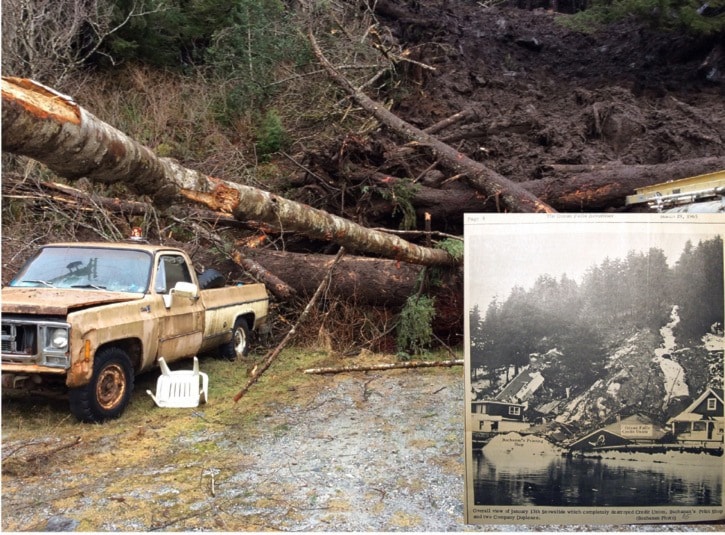The tiny community of Ocean Falls has experienced a large landslide in the exact same place as the fatal event that killed seven residents 50 years ago.
On January 25 at approximately 3:25pm, a landslide of mud, trees, rocks and debris buried the public road that connects Martin Valley residents to the rest of Ocean Falls.
50 years ago, on January 13, 1965, a muddy landslide full of snow and debris swept away an entire family and their neighbours, injured five people and left 350 people homeless. The devastation was intense, with the Vancouver Sun describing the scene as ‘panic, horror, and death.’
The 1965 slide was predicted by multiple old timers after townspeople supposedly “prayed for rain and got too much.” The Vancouver Sun described how two duplexes were twisted off their wooden foundations and hurled down 100ft bank onto the roofs of the Ocean Falls Advertiser and the Credit Union.
The event occurred as Ocean Fall’s 3000-plus residents were “spending a normal Wednesday night – in the beer parlours, at the movies, or playing darts with friends at the Legion Hall.”
Hudson’s Bay employees were taking inventory at the store when the power went out 10 minutes before the slide hit at 10pm.
Clare Langdale, a 28-year old resident on Ocean Falls and a paper maker at Crown Zellerbach’s plant, vividly recalled in a bedside interview in hospital: “We were sitting in our duplex kitchen when Bobby said the windows were rattling and a storm was blowing up.
“We looked out but there was no storm. The next we knew a rush of boulders, snow and water lifted the house and it went flying around. The house literally took off from its moorings.
“A second and a third wave hit, and then I was on the floor, tangled up with the table legs. Bobby was alongside me. My wife ended up in the basement, pinned there by a kitchen chair on one side and the chesterfield on the other.
“I was pinned against the wall by a big chunk of ice. I could move my feet, that’s all. I was standing on Bobby who was pinned under me on the floor.” It took rescuers 50 minutes to dig out his wife and the family lost everything as insurance wouldn’t cover the costs.
Fortunately, this last event was nowhere near as traumatic but the community of 25 full-time residents is cut off from their normal routine as they are stranded on one side of the slide.
Most of Ocean Falls’ residents live in the Martin Valley and the slide has blocked them from the BC Ferries dock and the post office. However, barges have been able to deliver food to alternative docks for the present time.
“The slide has blocked the only road we have,” said resident Sharron Cartier. “Unlike the last few events, we don’t have the capacity to deal with this ourselves. It’s just too large.”
Ocean Falls has undergone some dramatic changes in the past 50 years. From a booming industry town of over 3000 to a tiny hamlet of under 30 residents in a 50-year span, Ocean Falls is certainly a unique place to live.
Cartier, who retired in Ocean Falls full-time eleven years ago, says she really likes the remote living but it comes with its own set of challenges.
“If you can’t fix your own problems you’re not in good shape out here,” Cartier laughs. “And you have to really like your partner.”
Cartier said that most of Ocean Falls 25 or so residents are retired and sitting the 60 plus bracket. In the summer the population jumps to near 100 residents, as those with summer homes and charter businesses show up for the season. However, services are still very limited.
There is no hospital or nursing station, store of any kind, school or major infrastructure. The largest employer is the private hydro company, Boralex, who boasts five employees on rotating shifts.
Groceries are ordered from Port Hardy or Vancouver and delivered by barge approximately every two weeks. Cartier said she prefers the tiny hamlet to her hometown of Quesnel, saying she loves being on the water.
Interior Roads crews were on hand last week to survey the damage by air with a geo-technical engineer. The local roads area manager, geo-technical engineer, and an environmental consult did the assessment from the air and to ensure the area was safe to work in.
“We can’t just look at the road, we needed to get above the mountain range to ensure the area is safe,” said Todd Hubner, Ministry of Transportation District Manager for the Cariboo Region. “The next step is to get the engineer’s prescription, environmental plan, and then equipment to the site.”
Hubner said there are some challenges in getting equipment into the area to deal with the 30,000 cubic metres of debris, but did say that once crews are moving it should only take a day or so to get a lane open for traffic.
